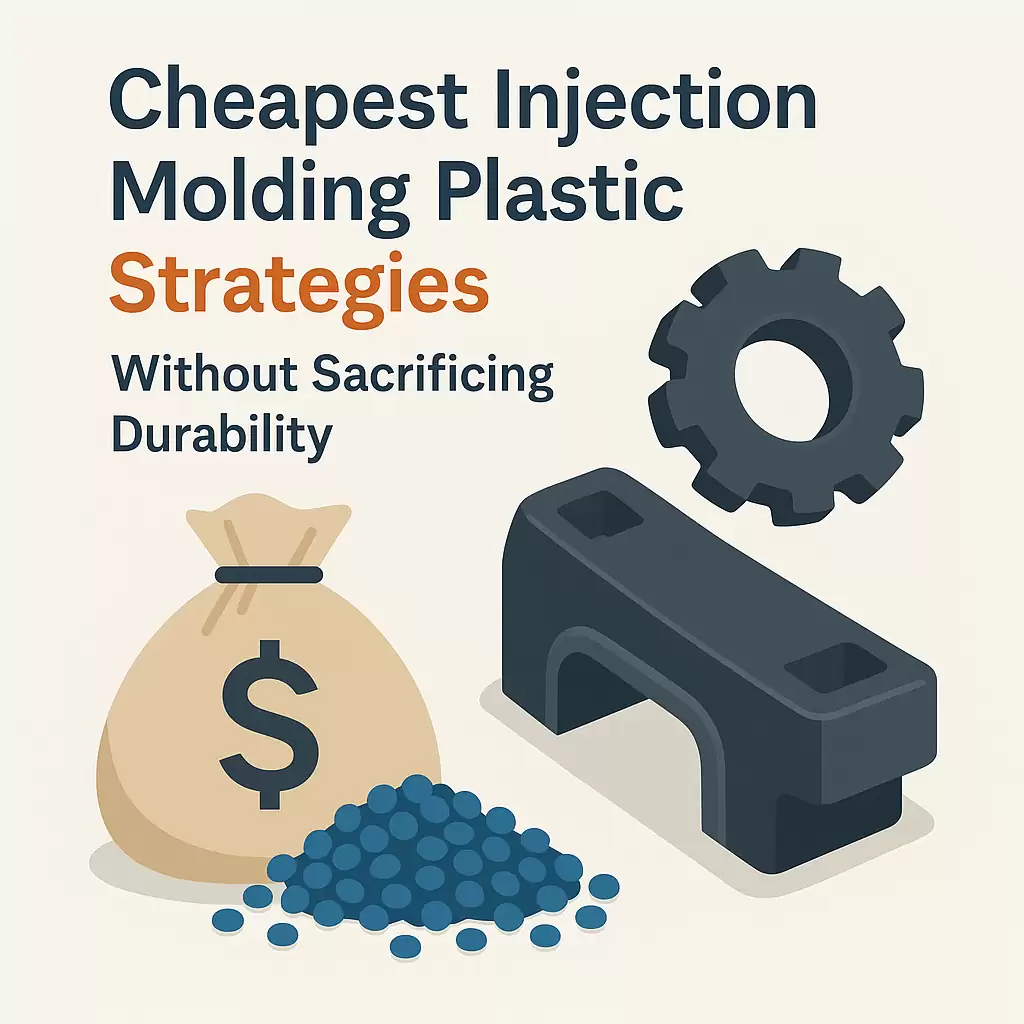Discover the Cheapest Injection-Molding Plastic Strategies — Without Sacrificing Durability
Discover the Cheapest Injection-Molding Plastic Strategies — Without Sacrificing Durability
Cutting resin expense is the fastest way to shrink the bill-of-materials, but chasing the absolute lowest price per kilogram can backfire if parts crack, warp, or fade in the field. The smarter play is to combine low-cost polymers with design tweaks, fillers, and process controls that preserve—or even enhance—mechanical performance. Use the framework below to drive material cost down while keeping warranty metrics (and your brand reputation) intact.
1 Start With the Right “Value-Core” Resin
| Budget Resin | Typical $/kg* | Built-In Strengths | Common Weaknesses | Durability Work-Arounds |
|---|---|---|---|---|
| PP-Copo | $1.10–1.50 | Chem-resistant, hinges well | Low stiffness, UV chalking | 10 – 20 % talc or 30 % GF; HALS UV masterbatch |
| HDPE | $1.05–1.35 | Impact to –40 °C, chem-resistant | Creep under load | Ribbing + mineral fill |
| Recycled PP/PE (PCR) | $0.80–1.10 | Lowest cost, ESG credit | Variable MFI, odor | Blend ≤ 30 % PCR with virgin; compatibilizer |
| HIPS | $1.20–1.60 | Easy processing, paint-ready | Brittle below 0 °C | Add 10 % impact modifier |
| Talc-Filled PP | $1.30–1.70 | High modulus, low price | Brittle drops | Maintain wall > 2 mm, use rounded ribs |
*Bulk Asia-Pacific contract pricing, Q2 2025.
2 Boost Durability With Low-Cost Fillers & Additives
-
Mineral / Talc (10 – 40 %) – Raises stiffness and heat deflection for < $0.10/kg premium.
-
Glass Fiber (20 – 30 %) – Quadruples tensile strength; use in ribs or local inserts to limit cost.
-
Elastomeric Impact Modifiers (5 – 15 %) – Restore drop resistance lost to mineral fill.
-
UV Stabilizer Masterbatch (0.5 – 2 %) – Pennies per part; prevents chalking and brittleness outdoors.
-
Controlled Regrind (≤ 15 %) – Internal runner or sprue scrap ground and blended back; zero raw-material cost.
Tip — Order additives as predispersed masterbatch; they disperse better in economy-grade polymers and cut compounding fees.
3 Design-for-Affordable Strength
| Element | Design Move | Cost/Durability Effect |
|---|---|---|
| Wall Thickness | 2 – 3 mm uniform + coring of thick areas | Saves resin; minimizes sink & cycle time |
| Ribs Instead of Walls | Rib ht. ≤ 3× wall, thick. 0.6× wall | Adds stiffness without weight |
| Snap-Fits Over Fasteners | Integrated latches, living hinges in PP | Removes metal BOM + assembly labor |
| Part Consolidation | Convert three covers to one family-mold part | Fewer tools, seals, QC points |
| Texture | MT-11000 or VDI 18 to mask flow lines | Allows cheaper hot-tip gating & faster cycles |
4 Process Tweaks That Lower Resin Expense per Part
| Lever | Typical Saving | How It Preserves Strength |
|---|---|---|
| Lower Pack Pressure | -3 – 5 % part weight | Prevents over-packing & stress whitening |
| Scientific Cooling (BeCu inserts, conformal channels) | -10 – 20 s cycle | Uniform crystallinity → consistent modulus |
| Hot Runner / Valve Gate | Eliminates cold sprues | Zero runner scrap; all resin becomes product |
| Micro-Foaming (MuCell™) | -10 % density | Micro-cellular core maintains skin strength |
5 Validate Value Engineering — Don’t Guess
-
DOE on Material Blends – Mix virgin, PCR, and additive levels; measure tensile & Izod.
-
Accelerated Aging – 1 000 h QUV or 504 h Xenon to verify UV package.
-
Drop & Torque Tests – Simulate worst-case user abuse.
-
CpK Tracking – Ensure low-cost resin blends still hit ±0.05 mm critical dims (target CpK ≥ 1.33).
6 Mini-Case: Appliance Handle Cost-Down
| Metric | Original ABS | 70 % PP-Copo + 20 % Talc + 10 % Regrind |
|---|---|---|
| Material Cost/kg | $2.40 | $1.25 |
| Part Weight | 85 g | 78 g |
| Notched Izod | 110 J/m | 95 J/m (still passes spec 80 J/m) |
| UV ΔE (500 h) | 1.4 | 1.2 |
| Annual Savings (250 k pcs) | – | ≈ US $240 k |
Zero field-returns after 18 months in service.
7 Fast-Track via TaiwanMoldMaker.com
-
48-Hour Material & Cost Matrix – Side-by-side pricing + mechanical data for > 600 local grades.
-
Bridge-Tool Programs – Aluminum or P20 tools credited toward steel once resin is proven.
-
Real-Time SPC Dashboards – Verify CpK doesn’t drift when regrind or PCR percentages change.
-
Integrated Testing Labs – QUV, salt-spray, and DSC on-site for rapid sign-off.
Key Takeaways
-
Start with a low-price core resin (PP, HDPE, HIPS) then add just enough filler or modifier to hit mechanical KPIs.
-
Design thinner, cored walls and rib for stiffness; material saved is margin gained.
-
Process control—hot runners, cooling, regrind rules—locks savings in every cycle.
-
A vetted supplier via TaiwanMoldMaker.com lets you experiment quickly while guarding quality metrics.
Ready to slash material cost without creating new warranty lines? Upload your CAD and performance targets to TaiwanMoldMaker.com for a no-charge, data-backed cost-down plan in 48 hours.









